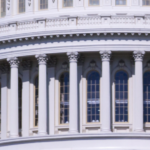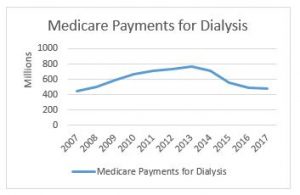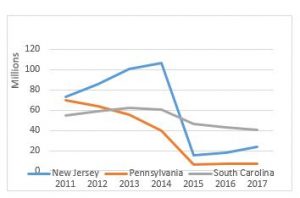Tag: Representative Terri Sewell (D-AL)
2024 AAA Legislative Awards
Written by Meghan Winesett on . Posted in Awards, Legislative, Legislative Awards, News, Press, Stars of Life.
The American Ambulance Association is proud to announce the winners of the 2024 AAA Legislative Awards. Each Member of Congress is being recognized for their strong advocacy for emergency medical services and their ongoing dedication to ambulance services across the United States. In addition to our two Legislator of the Year Awards and 25 Legislative Recognition Awards, the American Ambulance Association has named their first-ever EMS Legacy Award Winner. This award is reserved for a Members of Congress who made a substantial impact on the EMS industry during their tenure in the U.S. Congress.
2024 EMS Legacy Award
Senator Debbie Stabenow (MI)
2024 AAA Legislators of the Year
Congresswoman Marie Gluesenkamp Perez (WA-3)
Congressman Brad Finstad (MN-1)
2024 AAA Legislative Recognition Award Recipients
Senators
- Senator Jon Tester (MT)
- Senator Katherine Cortez Masto (NV)
- Senator Susan Collins (ME)
- Senator Bill Cassidy (LA)
- Senator Patty Murray (WA)
- Senator Jerry Moran (KS)
- Senator John Boozman (AR)
- Senator Shelley Moore Capito (WV)
- Senator Peter Welch (VT)
Representatives
- Congresswoman Terri Sewell (AL-7)
- Congressman Brad Wenstrup (OH-2)
- Congressman Buddy Carter (GA-1)
- Congressman Paul Tonko (NY-20)
- Congressman Andy Kim (NJ-3)
- Congressman Ryan Zinke (MT-1)
- Congressman Michael Guest (MS-3)
- Congressman Michael Bost (IL-12)
- Congresswoman Carol Miller (WV-1)
- Congresswoman Nikki Budzinski (IL-13)
- Congressman Darin LaHood (IL-16)
- Congressman Kelly Armstrong (ND- At Large)
- Congressman Emanuel Cleaver (MO-5)
- Congressman Lloyd Doggett (TX-37)
- Congressman Mike Carey (OH-15)
- Congresswoman Becca Balint (VT- At Large)
2023 AAA Legislative Awards
Written by Meghan Winesett on . Posted in Awards, Legislative, Legislative Awards, News, Press, Stars of Life.
The American Ambulance Association is proud to announce the winners of the 2023 AAA Legislative Awards. Each Member of Congress is being recognized for their strong advocacy for emergency medical services and their ongoing dedication to ambulance services across the United States.
2023 AAA Legislators of the Year
Senator Bill Cassidy, M.D (LA)
Senator Jon Tester (MT)
2023 AAA Legislative Recognition Award Recipients
Senators
- Senator Cortez Masto (NV)
- Senator Collins (ME)
- Senator Stabenow (MI)
- Senator Schumer (NY)
- Senator Lujan (NM)
- Senator Kaine (VA)
- Senator Murkowski (AK)
- Senator Tuberville (AL)
- Senator Murray (WA)
- Senator Moran (KS)
- Senator Boozman (AR)
Representatives
- Congressman Blumenauer (OR-3)
- Congresswoman Kelly (IL-2)
- Congresswoman Sewell (AL-7)
- Congressman Wenstrup (OH-2)
- Congressman Carter (GA-1)
- Congressman Tonko (NY-20)
- Congressman Davis (IL-7)
- Congresswoman Perez (WA-3)
- Congressman Finstad (MN-1)
- Congressman Pence (IN-6)
- Congressman Kim (NJ-3)
- Congresswoman Clark (MA-5)
- Congressman Zinke (MT-1)
- Congressman Guest (MS-3)
- Congresswoman Hoyle (OR-4)
- Congressman Bost (IL-12)
- Congressman Alford (MO-4)
Update on AAA Legislative Priorities
Written by on . Posted in Advocacy Priorities, Government Affairs, Member Advisories, Member-Only, News.
The American Ambulance Association has been working hard to accomplish the legislative goals of the membership in the 116th Congress. The AAA would like to take this opportunity to provide an update on what we have accomplished thus far in the 116th Congress.
Balance/Surprise Billing
Balance/surprise billing is a hot button issue that recently came into the spotlight at the start of the 116th Congress. With the President’s announcement calling for Congress to pass legislation that would end surprise billing for patients, there has been an increase in Congressional action on the issue including introduced legislation, discussion drafts and hearings in all committees of jurisdiction. The AAA has been working tirelessly with the Congressional committees of jurisdiction to educate Members and staff on the unique characteristics of EMS systems and that it would be inappropriate to apply the same restrictions on balanced billing to ground ambulance services.
The AAA has formed a working group comprised of AAA member volunteers that have worked on policy and messaging on balance billing. The working group has submitted comments to the Energy and Commerce Committee and Senate HELP committees advocating that the ambulance industry is unique from other stakeholders, and as such, should be looked at differently. Ambulance service providers and suppliers are required by law to treat and transport all patients, regardless of their ability to pay and are heavily regulated at the local level. The AAA has been working to communicate these factors that place the ambulance industry in a different situation than many other stakeholders.
Public Safety Officers Death Benefit (PSOB)
The Public Safety Officers Death Benefit (PSOB), a one-time benefit paid to families of first responders killed in the line of duty, is an issue that the AAA has passionately advocated for over many years. In the 116th Congress, the AAA has secured introduction of legislation in the House of Representatives, H.R. 2887, the Emergency Medical Service Providers Protection Act. H.R. 2887 would extend the PSOB to first responders employed by private for-profit EMS agencies. The AAA was able to secure several commitments from Members of Congress to cosponsor the legislation during Stars of Life meetings in Washington, DC. In addition to taking action to move H.R. 2887 through the legislative process, the AAA will be engaging in an outreach campaign in the next few weeks.
Dialysis Off-Set Restructuring
The AAA has worked toward reintroduction of legislation to restructure the offset that was passed into law in the Bipartisan Budget Act of 2018 (H.R. 1892) in the 115th Congress. This offset included a total cut of 23% to the Medicare reimbursement for basic life support (BLS) non-emergency transports performed by all ambulance service suppliers and providers to and from dialysis centers. This cut served as an offset to the 5-year extension of Medicare add on payments that our industry worked hard to get extended.
The AAA has secured introduction of legislation in both the House and Senate. H.R. 3021 was introduced by Representatives LaHood (R-IL) and Sewell (D-AL) and S. 228 by Senators Cassidy (R-LA) and Jones (D-AL). If passed, this legislation would change the cut that is currently in place so that it applies specifically to companies conducting over 50% ESRD non-emergency transports. Those ambulance services with over 50% ESRD transports would get a cut of 29.5%, while those doing less would receive a 15.5% cut. The AAA will continue to work toward movement and passage of this legislation that would better distribute the reduction to those providers which do almost exclusively non-emergency dialysis transports and thus have a lower cost of providing services.
Medicare Priorities Bill
The AAA has crafted legislation that is specifically aimed at addressing major Medicare ambulance industry issues. The issues that will be included in future legislation include making Medicare ambulance add-ons permanent, implementing a prior-authorization program across the nation, allowing for transportation to alternative destinations, reducing regulatory burdens, and providing relief through maintaining many zip codes as rural following the next census. The AAA is working to get this Medicare priorities legislation introduced in the coming months so that we can get to work on solving these Medicare issues that impact our industry as a whole.
VA Legislation
Another priority that that the AAA has been diligently working toward getting introduced is Veterans Affairs (VA) legislation. The Veterans Reimbursement for Emergency Ambulance Services Act (VREASA) introduced by Congressman Tipton (R-CO) would provide veterans with reimbursement for emergency ambulance services when a Prudent Layperson would have a reasonable expectation that a delay in seeking immediate medical attention will jeopardize the life or health of the veteran. This legislation was introduced as a result of the VA consistently requiring all medical records be provided, including the records of treatment after the emergency service has taken place. Should those records show that it was not a life threatening emergency or a false alarm, the claim for reimbursement is being denied. The VA legislation would mandate that the VA apply the “prudent layperson” definition of emergency to determine coverage of ambulance claims.
The AAA is also working toward addressing two other issues with the VA to enforce more prompt payment by the VA and treating the VA as the first payor, similar to Medicare, as it is determined whether there is a different primary payor. The AAA has been working with Senators Collins and Tester on language help solve this ongoing and serious reimbursement issue.
In our next update, we will be reporting on the progress the AAA has made this year on regulatory issues.
Questions? Contact Us
If you have questions about the discussion draft or balance billing initiatives being undertaken by the AAA, please do not hesitate to contact a member of the AAA Government Affairs Team.
Tristan North – Senior Vice President of Government Affairs
tnorth@ambulance.org | (202) 802-9025
Ruth Hazdovac – AAA Senior Manager of Federal Government Affairs
rhazdovac@ambulance.org | (202) 802-9027
Aidan Camas – Manager of State & Federal Government Affairs
acamas@ambulance.org | (202) 802-9026
Thank you for your continued membership and support
Talking Medicare: CMS Implements Further Dialysis Cuts
Written by Brian Werfel on . Posted in Advocacy Priorities, Member-Only, News, Reimbursement, Talking Medicare.
Talking Medicare: CMS Implements Further Cuts in Reimbursement for Dialysis Services; Medicare Payment Data Shows Continued Reduction in Overall Spending on Dialysis Transports, but Net Increase in Dialysis Payments in Prior Authorization States
On October 1, 2018, CMS implemented an additional thirteen (13%) cut in reimbursement for non-emergency BLS transports to and from dialysis. This cut in reimbursement was mandated by Section 53108 of the Bipartisan Budget Act of 2018. This on top of a ten (10%) cut in reimbursement for dialysis transports that went into effect on October 1, 2013. As a result, BLS non-emergency ambulance transports to and from dialysis that occur on or after October 1, 2018 will be reimbursed at 77% of the applicable Medicare allowable.
In related news, CMS has released its national payment data for calendar year 2017. This data shows a continued reduction in total Medicare payments for dialysis transports. Medicare paid $477.7 million on dialysis transports in 2017, down from $488.9 million in 2016. This continues a downward trend that has seen total payments decline from a high of more than $750 million in 2013 (see accompanying chart to the right). Not coincidentally, it was in 2013 that our industry saw its first reduction in Medicare’s payments for dialysis transports.
The payment reduction is partially the result of the reduction in the amounts paid for dialysis services. However, it is also reflective of an overall decline in the number of approved dialysis transports. For this, we can look primarily to the impact of a four-year demonstration project that requires prior authorization of dialysis transports in 8 states and the District of Columbia.
As a reminder, the original prior authorization states were selected based on higher-than-average utilization rates and high rates of improper payment for these services. In particular, the Medicare Payment Advisory Commission (MedPAC) had singled out these states as having higher-than-average utilization of dialysis transports in a June 2013 report to Congress. The chart below shows total spending on dialysis in those states in the years immediately preceding the implementation of the prior authorization project up through 2017, the third year of the demonstration project. While the three states had very different trajectories prior to 2015, each showed a significant decrease in total payments for dialysis under the demonstration project.
However, it is the trajectory of these changes that I want to discuss in this month’s blog. In previous blogs, I discussed the impact of the particular Medicare Administrative Contractor on the outcomes under prior authorization. Specifically, I noted that, while dialysis payments dropped in each state, the decline was far more dramatic in the states administered by Novitas Solutions (NJ, PA) than in the South Carolina, which was administered by Palmetto GBA. This trend continued in the second year of the program, which saw prior authorization expanded into five additional states and the District of Columbia. Those states administered by Novitas (DE, MD) saw far greater declines than the states administered by Palmetto (NC, VA, WV).
Given these declines, the data from the third year is somewhat surprising. The states administered by Palmetto continued to see declines in total dialysis payments, with the only exception being West Virginia. However, in the states administered by Novitas, we saw total dialysis payments increase, particularly in New Jersey, which saw nearly a 33% increase in total dialysis payments.
Three years into the prior authorization program, it is starting to become clear that the two MACs have approached the problem of overutilization of dialysis transports using two different approaches. Palmetto appears to have adopted a slow-and-steady approach, with total payments declining in a consistent manner year after year. By contrast, Novitas adopted more of a “shock the system” approach, where it rejected nearly all dialysis transports in the first year, and has adopted a somewhat more lenient approach in subsequent years.
Key Takeaways
Last year, I wrote that two years of data under the prior authorization program permitted two conclusions: (1) the implementation of a prior authorization process in a state will undoubtedly result in an overall decrease in the total payments for dialysis within that state and (2) the size of that reduction appears to be highly dependent on the Medicare contractor.
With an additional year of data, I think both conclusions remain valid, although I would revise the second to suggest that the initial reduction has more to do with the Medicare contractor. The evidence from the third year of the program suggests that the trends tend to equalize after the first few years. It is also possible that Novitas felt a more aggressive approach was needed in the first few years to address evidence of widespread dialysis overutilization in the Philadelphia metropolitan area.
This has potential implications beyond the demonstration project, as CMS looks towards a possible national expansion of the program. Among other issues, it suggests that the AAA must continue its efforts to work with CMS and its contractors on developing more uniform standards for coverage of this patient population.
What the AAA is Doing
The AAA continues to work on legislation that would restructure this cut to dialysis transport reimbursement. The AAA strongly supports the NEATSA Act (H.R.6269) introduced by Congressman LaHood (R-IL) and Congresswoman Sewell (D-AL) that would restructure the offset so that a majority of the additional reduction would be focused on those ambulance service agencies in which 50% or more of their volume are repetitive BLS nonemergency transports. AAA members and the AAA are working to get a Senate companion bill introduced shortly. The goal of this legislation would be to have the restructured offset go into effect as soon as possible. Thank you to the dozens of AAA members who have already contacted their members of Congress voicing their support for this critical legislation.
Have an issue you would like to see discussed in a future Talking Medicare blog? Please write to me at bwerfel@aol.com




